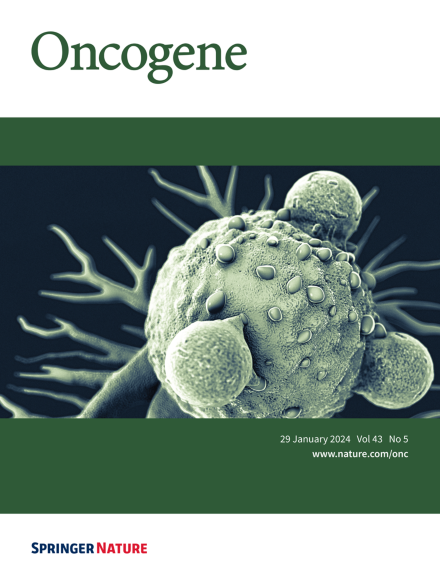lncRNA ST18- as1通过在细胞质中锚定FUS来增强ST18 mRNA的稳定性,从而抑制胰腺癌的进展。
IF 7.3
1区 医学
Q1 BIOCHEMISTRY & MOLECULAR BIOLOGY
引用次数: 0
摘要
胰腺导管腺癌(PDAC)死亡率高,生存时间短。长链非编码rna (lncRNAs)在PDAC的进展中起着重要作用。然而,与PDAC患者总生存期(OS)相关的预后lncrna仍然难以捉摸。RNA测序用于鉴定短期和长期PDAC患者之间lncRNA表达的差异。我们发现了一种新的lncRNA (ENSG00000253924),称为ST18-AS1 (st18相关的lncRNA),它在长期PDAC患者的组织中高度表达。高ST18-AS1表达与良好的临床结果相关,PDAC细胞系中上调ST18-AS1表达在体内和体外均可抑制细胞增殖,促进细胞凋亡。ST18- as1调控的关键下游靶点是抑制致瘤性18 (ST18)。我们还发现,与非肿瘤邻近组织(NATs)相比,PDAC组织中的ST18表达较低,较高的ST18表达与较好的临床结果相关。因此,ST18的强制表达抑制了肿瘤细胞的增殖,促进了细胞凋亡。机制研究表明,ST18- as1通过结合融合肉瘤(FUS)并在细胞质中锚定FUS来维持ST18 mRNA的稳定性。总的来说,我们发现ST18- as1是一种新的生物标志物,通过ST18抑制PDAC细胞增殖并促进PDAC细胞凋亡。靶向ST18- as1 /ST18可能是治疗PDAC的潜在治疗策略。本文章由计算机程序翻译,如有差异,请以英文原文为准。

The lncRNA ST18-AS1 suppresses pancreatic cancer progression by enhancing ST18 mRNA stability through anchoring FUS in the cytoplasm
Pancreatic ductal adenocarcinoma (PDAC) is associated with a high mortality rate and short survival time. Long noncoding RNAs (lncRNAs) play a significant role in the progression of PDAC. However, prognostic lncRNAs associated with overall survival (OS) in patients with PDAC remain elusive. RNA sequencing was used to identify differential lncRNA expression between short-term and long-term PDAC patients. We identified a novel lncRNA (ENSG00000253924), termed ST18-AS1 (ST18-associated lncRNA), that is highly expressed in the tissues of long-term PDAC patients. High ST18-AS1 expression was correlated with favorable clinical outcomes, and the upregulation of ST18-AS1 expression in PDAC cell lines suppressed cell proliferation and promoted apoptosis both in vivo and in vitro. The key downstream target regulated by ST18-AS1 was Suppression of tumorigenicity 18 (ST18). We also found that ST18 expression was lower in PDAC tissues compared to non-tumorous adjacent tissues (NATs) and that higher ST18 expression was correlated with better clinical outcomes. Accordingly, the forced expression of ST18 inhibited proliferation and promoted apoptosis in tumor cells. Mechanistic studies showed that ST18-AS1 maintained the stability of ST18 mRNA by binding to Fused in sarcoma (FUS) and anchoring FUS in the cytoplasm. Overall, we identified ST18-AS1 as a novel biomarker that inhibits PDAC cell proliferation and promotes PDAC cell apoptosis through ST18. Targeting ST18-AS1/ST18 may be a potential therapeutic strategy for treating PDAC.
求助全文
通过发布文献求助,成功后即可免费获取论文全文。
去求助
来源期刊

Oncogene
医学-生化与分子生物学
CiteScore
15.30
自引率
1.20%
发文量
404
审稿时长
1 months
期刊介绍:
Oncogene is dedicated to advancing our understanding of cancer processes through the publication of exceptional research. The journal seeks to disseminate work that challenges conventional theories and contributes to establishing new paradigms in the etio-pathogenesis, diagnosis, treatment, or prevention of cancers. Emphasis is placed on research shedding light on processes driving metastatic spread and providing crucial insights into cancer biology beyond existing knowledge.
Areas covered include the cellular and molecular biology of cancer, resistance to cancer therapies, and the development of improved approaches to enhance survival. Oncogene spans the spectrum of cancer biology, from fundamental and theoretical work to translational, applied, and clinical research, including early and late Phase clinical trials, particularly those with biologic and translational endpoints.
 求助内容:
求助内容: 应助结果提醒方式:
应助结果提醒方式:


